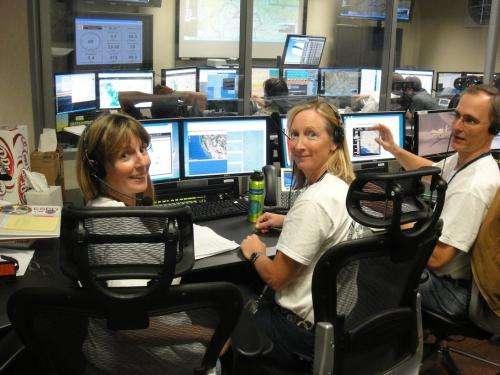HS3 project manager Marilyn Vasques and deputy project manager Bernadette Luna help develop daily mission plans that are based on satellite data and local weather predictions, and then are used to develop flight paths, and each take-off and landing. Credit: Vasques
Women at NASA have made important contributions to the agency's missions, since its founding in 1958. But, as recently as 20 years ago, the number of women in key technical and project management positions was small. In 1993, women were 11 percent of all managers at NASA. By 2012, women made up 30 percent of all NASA managers, according to a Workforce Information Cubes for NASA (WICN) report provided by the National Shared Services Center at NASA's Stennis Space Center in Bay St. Louis, Miss.
The increasing presence of women in management of science missions at NASA is exemplified by Marilyn Vasques and Bernadette Luna, both members of the Earth Science Project Office at NASA's Ames Research Center in Moffett Field, Calif., and key participants in recent and on-going NASA airborne missions to study hurricanes.
Marilyn Vasques is the project manager for the Hurricane and Severe Storms Sentinel (HS3) mission, and was the project manager of the successful Genesis and Rapid Intensification Processes (GRIP) mission in 2010. Both hurricane missions were science field experiments, conducted to better understand how tropical storms form and develop into major hurricanes. Although relatively new to airborne research, Bernadette Luna's management ability promoted her into the role of HS3 deputy project manager.
HS3 is a five-year mission specifically targeted to investigate the processes that underlie hurricane formation and intensity change in the Atlantic Ocean basin. The mission started in 2011 and had its first of three deployments last year, which included six successful flights by one of NASA's remotely piloted Global Hawk aircraft. Its instruments gathered data from hurricanes Leslie and Nadine, with flights as far away as the Azores, located about 930 miles (1,500 km) west of Lisbon, Portugal and about 1200 miles (1,900 km) southeast of Newfoundland, Canada.
This summer, the HS3 mission will continue to explore the role of the Saharan Air Layer in tropical storm formation and intensification, and the role of deep convection in the inner-core region of storms. Addressing these science questions requires sustained measurements over several years due to the limited sampling opportunities in any given hurricane season.
During each of the three deployment years of the HS3 mission, actual data collection by the aircraft only occurs within a four- to five-week period. To be ready for that science window, project managers Vasques and Luna work throughout the year to coordinate and integrate the mechanical and human elements of the HS3 into a comprehensive, fully operational mission. Project management includes NASA aircraft, payload integration, numerous science instruments, and juggling the demands of dozens of researchers.
"We staff 24-hour science flights, as well as the pre- and post-flight operations and mission planning. Mission plans are based on satellite data for science targets and local weather predictions for each take-off and landing 24 hours later," said Vasques.
This year, the project involves two Global Hawks, each with a different set of instruments. One will fly above the tropical cyclones, and the other in the environment around the storms. The NASA Global Hawks are autonomously controlled aircraft that, for HS3, deploy from NASA's Wallops Flight Facility in Wallops Island, Va.
To further accommodate the mission, NASA's Wallops provides aircraft and office space in their hangar, and also built a new operations center, called the Global Hawk Operations Center – East. This year, the mission will operate from this new ground station.
"It should be a really exciting and productive deployment. We have more than 200 people involved this year—aircraft technicians, mechanics, pilots, forecasters, and scientists," Luna said.
The HS3 mission is funded by NASA Headquarters under the Earth Venture program managed by NASA's Langley Research Center in Hampton, Va., The HS3 mission involves collaborations with various partners and many NASA centers.
NASA's airborne missions continue to refine their scientific methods and approach, successfully collecting short-lived data, building better instruments and models, and managing a broadened scope of expertise.
"Marilyn and Bernadette are both excellent managers, two of our very best," said Ed Sheffner, deputy division chief for Earth Science at Ames. "They have the confidence of the managers of NASA's airborne science and Earth science research programs and the science investigators who work with them."
More information: For more information about the Earth Science Project Office, visit: www.espo.nasa.gov
For more information about the HS3 Mission, visit: espo.nasa.gov/missions/hs3/ or www.nasa.gov/HS3
For more information about Women@NASA, visit: women.nasa.gov/
Provided by NASA
























